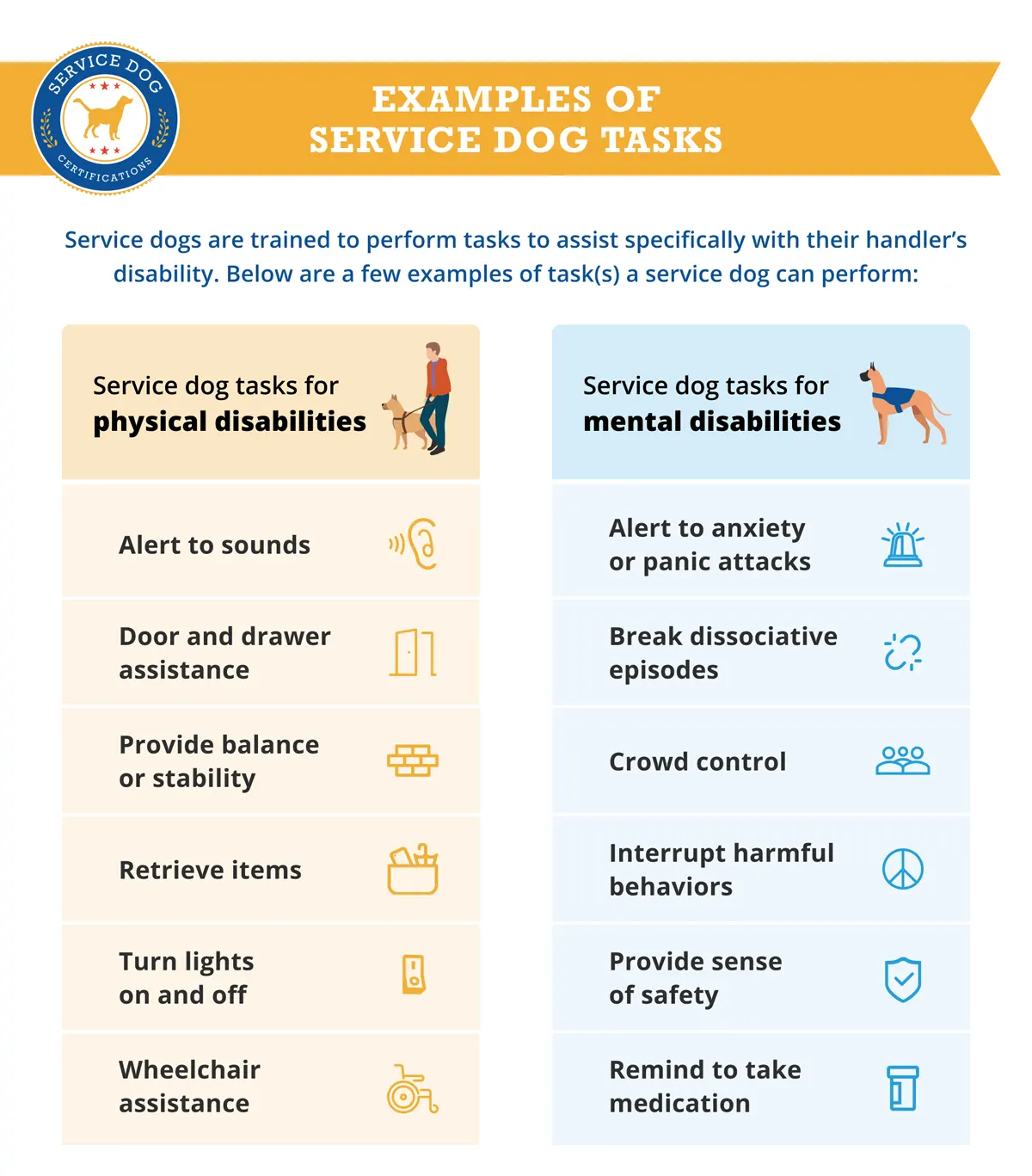Service Dog Training Guide: The Basics

Training your dog to become a service dog is easier and can be more cost-effective than you think, as there are options for you to train your dog yourself, hire a professional, or sign up for group classes.
If you train your service dog yourself, it’s highly recommended you become familiar with humane and positive reinforcement training techniques as well as become educated on canine care and health to ensure the dog is responding correctly and no damage to them or bad behaviors are being learned. In this article, we look at the phases of service dog training in more detail.
In this article:
- Mastering foundation skills
- Service task training
- Public access training
- Practicing reliability
- Keeping skills sharp with ongoing maintenance
Phase 1: Mastering Foundation Skills
Obedience skills aren’t just “nice to have” — they’re the foundation upon which everything else builds. Service dogs must respond to commands instantly in any situation, even potentially dangerous ones. ADA service dog rules require you to maintain control of your service dog at all times, so reliable command response isn’t optional.
Start training in a quiet, distraction-free space before gradually adding challenges. Your service dog needs to master these essential commands:
- Sit and Down: Teach these separately, then build staying power. Begin with quick 10-second holds and work up to 2-3 minute stays.
- Stay: Start small — 5-second stays with you just 2 feet away. Gradually increase both time and distance until your dog can hold a rock-solid stay for 3+ minutes with you at least 20 feet away.
- Come: This command could literally save your dog’s life. Practice first in enclosed areas, then add a long training line in open spaces. Never punish a dog that comes when called (even slowly), as this teaches that coming to you leads to bad things.
- Heel: Begin with short 30-second walking sessions, rewarding your dog for staying in the perfect position. Over time, build up to 5+ minutes of consistent heeling.
- Leave it/Drop it: These safety commands are crucial in public. Start with boring items your dog doesn’t care much about, then gradually work up to more tempting objects.
Keep sessions short (5–15 minutes) but frequent (3–5 times daily) rather than drilling for hours. This keeps your dog mentally fresh and excited about training.
Smart Socialization: Building Confidence
Contrary to popular belief, socialization isn’t about meeting every person and dog possible. It’s about teaching your dog to stay calm and confident in all kinds of situations. An under-socialized dog will fall apart exactly when you need help the most — when facing something unfamiliar or startling.
Focus your socialization efforts on:
- People diversity: Expose your dog to people of different ages, heights, and appearances. Include people wearing hats, uniforms, bulky coats, and people using wheelchairs, crutches, or walkers.
- Environmental variety: Let your dog experience different floor surfaces (slippery tile, carpet, metal grates), stairs, automatic doors, and various weather conditions. Visit buildings with different sounds and acoustics.
- Sensory experiences: Introduce your dog to common noises like vacuum cleaners, lawnmowers, car alarms, children playing, and music — sounds they’ll encounter during regular service work.
Use the “distance-first” approach: Start from a comfortable distance rather than throwing your dog into overwhelming situations. For example, sit on a bench where your dog can observe children playing from afar, then move closer only as they remain calm and interested.
Impulse Control
Impulse control is what separates service dogs from well-behaved pets. Your dog must resist temptations in public — dropped food, other animals, friendly strangers — and stay focused on you. Without strong impulse control, your dog might abandon their post to investigate distractions exactly when you need assistance.
Build impulse control through:
- Doorway manners: Your dog waits while you open any door, then crosses only when you release them. Start practicing with interior doors before moving to more exciting exterior doors.
- Food restraint: Place treats on the floor or even on your dog’s paws, requiring a “wait” until you give a “take it” cue. Gradually increase difficulty with longer waits and more tempting foods.
- Greeting protocol: Teach your dog to stay sitting or lying down when meeting people instead of jumping up or seeking attention.
Always reward your dog exactly where they’re showing restraint. If they’re maintaining a “stay” at the doorway, bring the treat to them there instead of calling them to you for the reward, which teaches them to break position.

Phase 2: Service Task Training
Service dogs aren’t just well-behaved pets — they must perform specific tasks that directly help with your disability. This isn’t about emotional support or comfort (though those are nice bonuses). It’s about trained behaviors that actively help manage your condition.
Without identifying the right tasks, you might spend months training behaviors that don’t actually qualify as service dog work or that your dog physically can’t perform reliably. When a business owner asks, “What tasks does your dog perform to help with your disability?” — which they legally can — you need a clear, specific answer.
Check out our comprehensive list of service dog tasks to get ideas about what these dogs can do for various disabilities.
Breaking Down Complex Tasks
Think of teaching complex service dog tasks like building a house — you can’t start with the roof! Most helpful tasks involve complicated behavior chains that dogs would never do naturally.
Trying to teach an entire task like “retrieve my medication” or “alert to low blood sugar” all at once usually leads to confusion and frustration for both you and your dog. Instead, break each task into small, manageable pieces that build on each other.
For example, if you’re teaching retrieval, the separate steps might include:
- Recognizing the specific item by name or scent
- Picking it up properly without damaging it
- Holding it securely without dropping or chewing it
- Carrying it back to you directly
- Releasing it gently into your hand
Master each step completely before connecting them together. This approach makes training clearer for your dog and lets you fix specific problems without starting over.
Making Tasks Bulletproof
There’s a big difference between a dog performing tasks in perfect training conditions and performing when you’re actually having symptoms and need help. Task refinement bridges this gap.
In early training, you’re likely working in quiet environments with lots of guidance. But real disability support happens in unpredictable settings when you might be unable to give perfect cues or help your dog succeed.
Build reliability through these steps:
- Duration: Gradually extend how long your dog must perform. If you need deep pressure therapy during anxiety attacks, start with 10 seconds of sustained pressure, then work up to 2+ minutes.
- Distance: Increase the space between you while maintaining reliability. Your dog should eventually retrieve items from 10+ feet away or alert to your symptoms from across a room.
- Distractions: Slowly add challenges while requiring perfect performance. Start with quiet talking nearby, then add more intense distractions like other dogs or loud noises.
- Putting it all together: Finally, link multiple behaviors into complete sequences. For example, train your dog to not only find another person when you need help but also lead that person back to you.
This refinement process creates a service dog who performs reliably when you need them most — even when you’re experiencing symptoms and can’t provide perfect guidance.
Share this image on your site
Phase 3: Public Access Training
The key word in public access training is “gradual.” Think of it like teaching someone to swim — you don’t start in the deep end! Throwing your dog into overwhelming situations too quickly can create fear that’s hard to overcome.
When you build exposure step by step, your dog learns to handle each new challenge with confidence. It’s like building a ladder — each rung needs to be solid before you climb to the next one. This careful approach also helps you spot your dog’s specific triggers (like fear of automatic doors or children) early on when they’re easier to address.
Here’s a simple progression that works for most dogs:
- Start with peaceful places: Empty parks or quiet sidewalks during off-hours. Just practice basic commands with minimal distractions.
- Move to calm businesses: Try pet-friendly stores during their slowest times. Home improvement stores are great for this — they have different floor surfaces and moderate activity but aren’t overwhelming.
- Step up to busier places: Once that’s comfortable, try busier stores, outdoor shopping areas, and restaurants with outdoor seating.
- Graduate to challenging environments: Finally, work up to grocery stores, malls, and food courts — places with many distractions, smells, and activities.
Remember the “3–visit rule” for each new place: The first visit is just about getting comfortable, the second is for basic work, and the third is for more serious training. Don’t rush — taking an extra month in training is better than creating fear that might never fully resolve.
Perfect Public Behavior
Businesses can legally ask your service dog to leave if they’re disruptive, even if they’re perfectly trained in their actual assistance tasks. A dog that barks, has accidents indoors, approaches strangers, or can’t settle quietly can lose their public access rights under the ADA, no matter how well they perform their disability tasks.
Your dog needs to master these essential public behaviors:
- Quiet settling: Your dog should calmly lie under tables or beside chairs for at least 30 minutes without getting restless. Start practicing this at home during your meals, then try outdoor cafés, before moving to indoor restaurants.
- Moving through tight spaces: Your dog needs to stay close beside you through narrow store aisles, between restaurant tables, and in crowded areas without bumping into things or people.
- Elevator manners: They should enter calmly, stay in position during the ride, and exit in a controlled way. Start with empty elevators during quiet hours.
- Ignoring temptations: Deliberately drop food near your dog during practice sessions (start with boring food before trying more tempting items). This prepares them for the inevitable dropped french fry at a restaurant.
Here’s a training hack: Set up a fake “restaurant” at home with a table, chairs, and family members eating a meal. Have your dog practice settling underneath while everyone eats. Once they’ve mastered this controlled setting, move to a quiet outdoor café and finally to indoor restaurants during less busy times.

Getting Around: Transportation Training
Your service dog’s ability to handle different transportation can make or break your independence. A dog that panics on buses or can’t handle a subway ride significantly limits where you can go for medical appointments, work, or social activities.
Build transportation skills in this order:
- Car rides: Make sure your dog has a consistent position in the vehicle where they stay calm without climbing around or showing anxiety.
- Elevators and escalators: For elevators, practice calm entry/exit and stay in position during the ride. Escalators require special care — first practice on non-moving ones to teach safe paw placement. Many handlers skip escalator training entirely due to paw injury risks, so consider whether you need this skill.
- Public transportation and flights: Buses have unique challenges like sudden stops, tight spaces, and frequent rider changes. Trains and planes add noise, crowds, and longer durations. Start with short trips during quiet times and gradually increase difficulty.
Safety tip: If you do train for escalators, be extremely careful. Start on turned-off escalators, use high-value treats, and consider carrying small dogs. Many service dog trainers recommend avoiding escalators entirely and using elevators instead.
Show your service dog has mastered the public access test with a Handler-Certified Public Access Test Certificate.
Phase 4: Practicing Reliability
Think of it this way: your dog might be perfect at performing tasks at home, but that’s like practicing basketball in an empty gym. The real game happens with screaming fans, other players, and pressure. The same goes for your service dog.
Your dog needs to learn how to help you while dealing with all the distractions of real-life — people walking by, interesting smells, loud noises, and busy environments. This is much harder than performing tasks in your quiet living room.
To build this skill:
- Practice where you actually go: Take your dog to the places you visit regularly — your workplace, favorite coffee shop, grocery store, and doctor’s office. Each new place adds a new challenge.
- Mix up the tasks: Don’t always ask for the same task in the same order. If your dog learns, “We always do task A, then task B,” they might start doing things automatically rather than listening to what you actually need in the moment.
- Build stamina gradually: Start with short 15-minute outings and slowly work up to longer sessions of 2+ hours. Watch for signs your dog is getting tired or stressed (yawning, looking away, shaking off).
For example, if your dog is trained to help with anxiety, start practicing in a quiet park, move to a small shop with few customers, and eventually test their skills in busier places like malls with more noise and activity.
Testing Under Pressure
The hardest truth about service dog work is that your dog needs to perform at their best exactly when conditions are at their worst. Think about it — you’re most likely to need help during a medical emergency, an anxiety attack, or in overwhelming environments. Many dogs that seem well-trained can fall apart during these critical moments.
To make sure your dog is ready for these situations:
- Create safe practice scenarios: Set up controlled situations that mimic stressful events. Have a friend suddenly drop something nearby or create unexpected noises while your dog performs a task.
- Check their recovery time: How quickly can your dog refocus on you after something startling happens? A well-trained service dog should recover within seconds.
- Practice during symptom flare-ups: If safe to do so, practice having your dog assist you when you’re actually experiencing mild symptoms of your disability, not just when you’re feeling your best.
- Test their endurance: Make sure your dog can handle working for as long as your typical day requires without getting too tired to help you.
Remember, the point isn’t to stress out your dog — it’s to make sure they can handle real-life situations. Always end these practice sessions on a positive note with success and rewards.
Phase 5: Keeping Skills Sharp with Ongoing Maintenance
Think of your service dog’s training like a musical instrument — even professional musicians practice daily. Without regular practice, your dog’s skills will get rusty and deteriorate, especially tasks they don’t use every day.
For example, a dog trained to respond to seizures might go months between actual episodes, or a dog trained to retrieve emergency medication might rarely need to use that specific skill. But when these emergency skills are needed, they must work perfectly the first time.
Regular practice keeps all your dog’s skills sharp and ready for action. It’s not about teaching them anything new — it’s about making sure they remember everything they’ve already learned.
Simple Training Schedule
Here’s an easy way to keep your dog’s skills fresh:
- Every day (5-10 minutes): Practice basic commands during normal activities. Ask for a “sit” before meals, practice “heel” during walks, or work on “stay” while you’re making coffee.
- Every week: Run through all of your dog’s special tasks, especially ones they don’t use often. If your dog is trained to press emergency buttons or retrieve specific items, practice these skills even if you haven’t needed them lately.
- Every month: Take your dog to a challenging environment they don’t visit often — maybe a busy store, public event, or restaurant — to keep their public behavior skills polished.
- Every three months: Do a complete check-up of all your dog’s skills. Test everything they know and look for any weak spots that need extra attention.
Many handlers find it helpful to use a simple calendar to track what skills to practice each day. This way, you don’t overwhelm yourself or your dog but still cover everything regularly.
Growing Together
As your disability changes, your service dog’s skills should evolve too. Many conditions change over time — mobility issues might worsen, symptoms might present differently, or new challenges might emerge.
To keep your service dog’s assistance relevant:
- Check-in with yourself: Every few months, consider whether your needs have changed. Are there new tasks that would help you? Are some tasks no longer as helpful?
- Build on what works: When teaching new skills, start with what your dog already knows. If your dog retrieves items well, they can learn to open drawers or refrigerators to get items. If they already alert you to sounds, they might learn to alert you to new sounds like medical devices.
- Gradual additions: Don’t try to teach several new skills at once. Add one new skill at a time while continuing to practice established tasks. Set aside specific training sessions for new skills while maintaining regular practice of core abilities.

Frequently Asked Questions about Service Dog Training
- Are service dogs required to have certification or complete a specific number of training hours?
- Who is responsible for ensuring a service dog meets proper training standards?
- What does the ADA require from service dog handlers to prove training?
- How long does service dog training typically take?
- Can I train my own service dog?
- What are the benefits of self-training my service dog?
- What about costs?
- What challenges should I expect if I self-train my service dog?
- Can any dog become a service dog with proper training?
- How do I know if my dog is making appropriate progress during training?
- Is it better to train a puppy or an adult dog for service work?
- What if my service dog in training isn’t making progress?
Are service dogs required to have certification or complete a specific number of training hours?
You might be surprised to learn that there’s no federally mandated certification process or required training hours under the ADA. That doesn’t mean it’s easy to train a dog to become a service dog — quite the contrary. Effective service dogs need comprehensive training to perform their essential work, but the government doesn’t regulate exactly how that training happens.
Who is responsible for ensuring a service dog meets proper training standards?
As a handler, you and you alone are responsible for ensuring you have a qualifying disability and that your dog meets behavioral standards and can perform specific tasks related to your disability. The ADA places the responsibility directly on you, not on certifications or third-party verification.
What does the ADA require from service dog handlers to prove training?
Under the ADA, you’ll need to:
- Self-attest to your disability status when asked
- Ensure your dog is trained to perform tasks directly related to your disability
- Maintain control of your dog at all times in public
- Make sure your dog is housebroken and well-behaved
How long does service dog training typically take?
While there’s no official standard in the US, many professionals follow guidelines of approximately 120 hours of training spread over six months, with at least 30 hours focused specifically on public access skills.
Your individual training program may vary significantly based on:
- Your dog’s temperament and learning style
- The complexity of tasks your dog needs to master
- Your consistency with training sessions
- Environmental factors and available training resources
Some handlers find their dogs ready for full service work after 6-8 months of dedicated training, while others may spend up to two years developing all necessary skills. Remember that rushing the process can lead to gaps in training that may create problems later.
Can I train my own service dog?
Yes, you can train your service dog yourself rather than working with a professional organization. The ADA allows you to self-train a service dog without third-party help. However, be prepared for a significant time commitment and potential challenges along the way. Don’t hesitate to consult a professional trainer if you encounter difficulties — their expertise can be a game-changer in overcoming specific training obstacles.
What are the benefits of self-training my service dog?
Self-training your service dog creates a unique partnership from day one. When you get a fully trained service dog from a program, there’s often a transition period where both handler and dog need to learn to work together — imagine trying to learn a dance with a skilled partner who’s used to dancing with someone else. The dog needs to adjust to your specific movement patterns, verbal cues, and daily routines, while you need to learn all their trained commands and behaviors. It can take weeks or months to truly sync up.
In contrast, when you train your service dog, you learn to dance together from the first step. Every command and every task is built around your specific needs, voice, and way of moving. You’ll shape their training around what works best for both of you, and a special bond comes from being both trainer and handler. Plus, there are no lengthy waiting lists to endure — you can start building that relationship right away, and many states, like Texas, even support your journey by granting service-dog-in-training access rights.
What about costs?
The cost to train a service dog can vary greatly depending on how you train, the tasks you need, and how your dog learns the best. Check out our guide on how much it costs to train a service dog to get a better idea.
What challenges should I expect if I self-train my service dog?
The sheer time commitment of service dog training often catches owner-trainers off guard. Needing 120 hours over six months is not uncommon, and the reality can be more intense. What starts as teaching basic retrieval can take months to develop into reliable service work — first, your dog learns to pick up a specific item at home, then different objects, then in new locations, and finally amid real-world distractions. Every task must be broken down into small steps and mastered before moving forward, and progress isn’t linear. You might spend weeks perfecting a task at home only to start almost from scratch when you begin practicing in public.
Your service dog also has to master public access. Your service dog in training needs to remain focused on you and their job while navigating a world of challenging distractions. They must maintain composure when other dogs bark at them in stores, stay calm when strangers try to pet them without asking and resist the temptation of food at nose level in restaurants. Even after months of solid training, some dogs begin showing stress signals or develop unexpected fears of everyday situations like automatic doors or crowds. No matter how well they perform their tasks, you must always watch for signs that the work might be too stressful for them to monitor whether your dog is emotionally equipped for the demanding life of a service dog.
Can any dog become a service dog with proper training?
While the ADA doesn’t specify breed restrictions, not every dog has the temperament or physical capability to become a service dog. The ideal candidate should be calm, focused, non-reactive, and physically capable of performing the necessary tasks. Before investing in extensive training, have your dog’s temperament tested and honestly assess whether they have the natural disposition for service work.
How do I know if my dog is making appropriate progress during training?
Progress in service dog training rarely follows a linear path. Generally, your dog should be consistently mastering skills in increasingly challenging environments. Create a training log to track specific behaviors, noting successes and challenges in different settings. If your dog repeatedly struggles with a particular skill despite multiple training approaches, consider consulting with a professional trainer to evaluate whether you need a different training strategy or if the dog might not be suitable for service work.
Is it better to train a puppy or an adult dog for service work?
Both approaches have advantages. With puppies, you can shape their development from the beginning, but you won’t know their adult temperament with certainty until they mature. Adult dogs (1–2 years old) have established temperaments, making it easier to assess their suitability for service work, but may have developed habits that need to be addressed. The best approach depends on your specific situation, including your disability needs, experience level, and timeline.
What if my service dog in training isn’t making progress?
Not all dogs are suited for service work, even with extensive training. If your dog consistently shows stress, fear, or inability to focus in public settings despite proper training approaches, it may be time to reassess their suitability. This difficult decision shows respect for the dog’s wellbeing and your needs. Many experienced service dog handlers have “career-changed” dogs before finding their successful working partner. Remember that a dog can be an excellent pet but not suited for the demands of service work.
Register Service Dog HereAbout the Author: The writing team at Service Dog Certifications is made up of folks who really know their stuff when it comes to disability laws and assistance animals. Many of our writers and editors have service dogs themselves and share insights from their own experiences. All of us have a passion for disability rights and animals.
Latest Posts

Dangerous Materials Hiding in Your Dog Products
Jake’s German Shepherd began developing strange rashes around his collar. Three vet visits later, they figured out the leather was treated with chromium — a chemical that irritates sensitive skin. Jake had no idea his dog’s collar contained industrial chemicals. Most dog owners don’t know what goes into the products they buy. Many companies use […]

Read More

Can You Bring a Service Dog to a Basketball Game?
Yes, you absolutely can bring your service dog to basketball games. Whether you’re heading to your local high school tournament, a packed college rivalry game, or splurging on NBA tickets, the Americans with Disabilities Act protects your right to be accompanied by your service dog anywhere the public can go. When you arrive, venue employees […]

Read More

Best Pet Health Insurance Providers
If you own a pet, you know how important — and expensive — vet care can be. One way to offset those costs is to purchase pet health insurance. Like typical health insurance, pet insurance is available at many price points, and can cover all, most, or only some of your vet-related costs. It can […]

Read More
